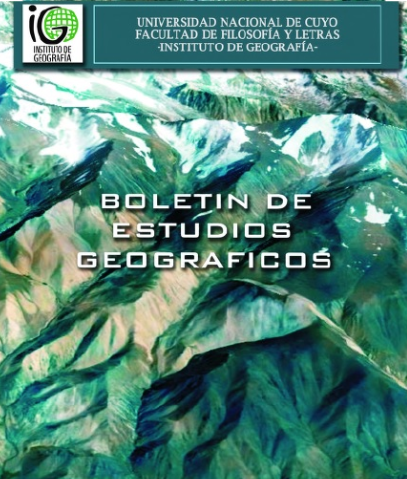Temporal variability of vegetation index in forested metropolitan areas. A preliminary comparative analysis of La Plata, Mendoza, Santiago de Chile and Turin cities
Keywords:
vegetation index, urban morphology, sostenible developmentAbstract
The knowledge of current conditions and recent changes in urban vegetation cover has begun through the analysis of temporal variability of the "normalized difference vegetation index" (NDVI) of four forested cities, comparing the images provided by satellite data for the summer periods 1986-2011. Methodologically, a preliminary
comparative analysis of correlations and trend estimation was carried out, of importance for understanding the interrelationship between urban morphology and green infrastructure.
The results obtained indicate a general decreasing tendency of mean NDVI values. In the Turin metropolitan area, the index variation was not significant. Negative correlations were determined between NDVI and population, moderate negative correlations between NDVI and the size of the metropolitan area; while preliminary
correlations between NDVI and climate variables did not follow the same scheme in the different metropolitan areas.
In the future, it is hoped to define criteria of urban design appropriate for forested cities, which will enable the sectors responsible for the protection of the habitat to manage, design and implement feasible design responses towards the future, within the framework of urban and environmentally sustainable energy development.
References
AKBARI, H. (2002). Shade trees reduce building energy use and CO2emissions from power plants. Environ. Pollut. 116, S119–S126.
ARMSON, D., Stringer, P., Ennos, A.R. (2012). The effect of tree shade and grass on surface and globe temperatures in an urban area. Urban Forest. Urban Greening 11, 245–255.
BERNATZKY, A. (1982). The contribution of trees and green spaces to a town climate. Energy Build.
BLOCK, A.H.; LIVESLEY, S.J., WILLIAMS, N.S.G. (2012). Responding to the Urban HeatIsland: A Review of the Potential of Green Infrastructure. Victorian Centre forClimate Change Adaptation Research Melbourne.
BREHENY, M. (1996). Centrist, Decentrists and Compromisers in The Compact City. E & FN Spon, London.
CHAVEZ, Pat S. Jr. (1996). Image-Based Atmospheric Corrections– Revisited and Improved. Photogrammetric Engineering and Remote Sensing 62 9: 1025-1036. Dirección Meteorológica de Chile. Dirección General de Aeronáutica Civil de Chile. http://www.meteochile.cl/
DI RIENZO J.A., et al. (InfoStat versión 2018). Grupo InfoStat, FCA, Universidad Nacional de Córdoba, Argentina. URL http://www.infostat.com.ar Earth Observation Group. NOAA National Geophysical Data Center. https://ngdc.noaa.gov/eog/night_sat/nightsat.html and www.lightpollutionmap.info
GIVONI, B. (1998). Climate considerations in building and urban design. John Wiley & Sons, Inc., USA.
GÓMEZ MUÑOZ, V.M., PORTA GÁNDARA, M.A., FERNÁNDEZ, J.L. (2010). Effect of tree shades in urban planning in hot-arid climatic regions. Landsc. Urban Plann. 94,149–157.
HEISLER (1986). Effects of individual trees on the solar radiation climate of small buildings. Urban Ecology Volume 9, Issues 3–4, 337-359. Special Issue Ecology of the Urban Forest II.
INDEC. Instituto Nacional de Estadística y Censos de la República Argentina 2010. http://www.indec.gob.ar/.
INE. Instituto Nacional de Estadísticas de Chile. http://nuevoportal.ine.cl/
IRONS, James R. NASA Official. Landsat Science. (Actualización julio 6. 2017). https://landsat.gsfc.nasa.gov/the-worldwide-reference-system/.
ISTAT. Istituto Nazionale di Statistica. https://www.istat.it/
LOUGHNER, C.P. (2012). Roles of urban tree canopy and buildings in urban heat island effects. J. Appl. Meteorol. Climatol.51, 1775–1793.
MASCARÓ, L. (1996). Ambiencia urbana. European Comisión, Directorate-General XVII, Energiy. Faculdade de Arquitetura UFRGS. Sagra D.C. Luzzato Editores, Porto Alegre.
MASEK, J. G., et al. (2006). A Landsat surface reflectance data set for North America, 1990 – 2000, Geosci. Remote Sens. Lett., 3, 68 – 72.
MCPHERSON, E. G. (1992). Accounting for benefits and cost of urban greenspace. Landscape and Urban Planning.
MONTEITH, J.L. y UNSWORTH, M.H. (1990). Principles of Environmental Physics, 2da ed.Edward Arnold, Londres.
MORAN, M. S. et al. (1992). Evaluation of simplied procedures for retrieval of land surface reflectance factors from satellite sensor output. Remote Sensing of Environment, 41, 169±184.
OKE, T. R. (1988). The urban energy balance. Prog. Phys. Geogr. 12: 471–508.
OWENS, S. (1986). Energy planning and urban form. London: Pion Ltd.
ROWNTREE, R.A. (1986). Ecology of the urban forest - Introduction to Part II. Urban. Ecology, 9: 229- 243.
SANTAMOURIS, M. (2000). Energy and Climate in the Urban Built Environment. James and Jamnes. London.
Servicio Meteorológico de la Fuerza Aérea Italiana. http://www.meteoam.it/
Servicio Meteorológico Nacional de Argentina. https://www.smn.gob.ar/
SIMPSON, J.R. (2002). Improved estimates of tree-shade effects on residential energyuse. Energy Build. 34, 1067–1076.
TOOKE, T.R., et al. (2011). Tree structure influences on roof top-received solar radiation. Landsc. Urban Plann. 102, 73–81.
ZHANG, H.K., ROY. D.P. (2016). Landsat 5 Thematic Mapper reflectance and NDVI 27-year time series inconsistencies due to satellite orbit change. Remote Sensing of Environment 186, 217–233.



































